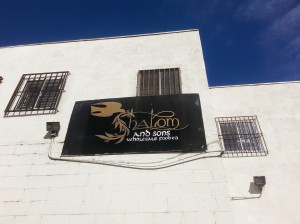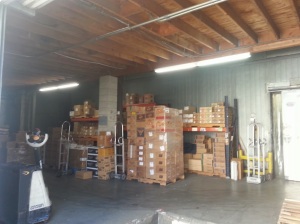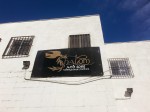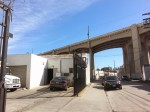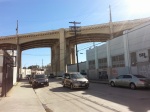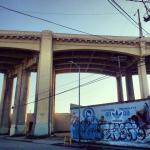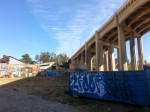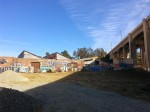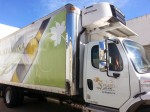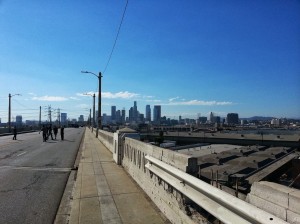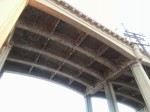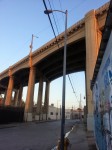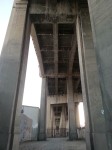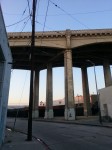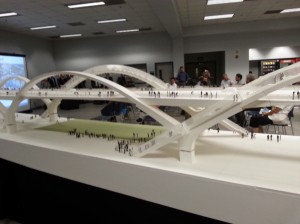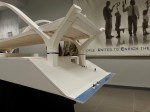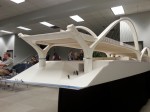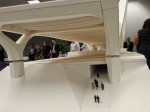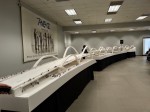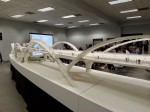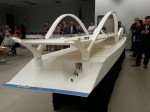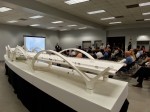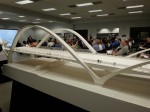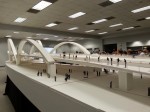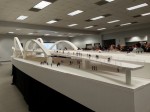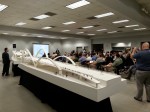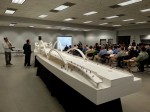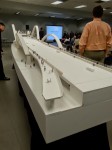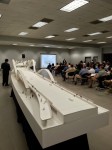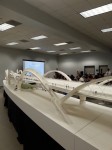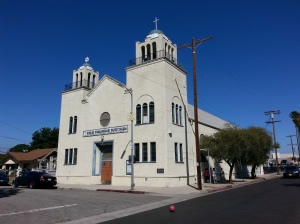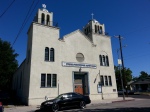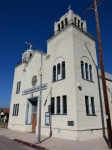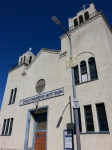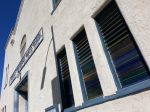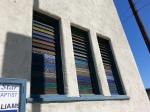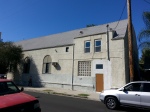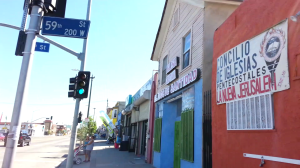The Final Days of the Kosher Food and Wine Business of Boyle Heights
One of the leasts known facts about the community of Boyle Heights, is that until recently it remained a very relevant hub in the daily Jewish life. Up until the past month, our kosher wines and foods used to be mostly distributed from right here in the lower industrial section of the Flats.
In the shadow of the classic Sixth Street Bridge, sat two special Jewish business. Which were located in the lower industrial section on Anderson Road.
The larger of the kosher food plants used to be run by Teva Foods:
“At Teva Foods, we bring together the goodness of nature and the flavors of fine Mediterranean cuisine in every pack of our Hummus, Dip and Salad. We use only the freshest ingredients, handpicked by our team of experts, to make sure that what you eat is healthy and tasty.”
Many of our local residents were employed at this plant, doing jobs like peeling the raw garlic for their products. Processing natural products under the supervision of the Orthodox Union.
The other the business has been my favorite by far, Shalom and Son’s Wholesale Foods:
“Shalom & Sons is a family owned full service direct store delivery distributor of kosher and health food products in Los Angeles, California. As a company, we are dedicated to providing outstanding service, while responding to the every day needs of the retail and institutional industries. We currently service the greater Los Angeles area, as well as the cities of Orange County, Santa Barbara County, San Francisco, San Diego, San Jose, Arizona and Las Vegas.
“Shalom & Sons represents some of the largest food manufacturers in the kosher and health food industries, and is the exclusive west coast distributor of many kosher product lines…”
Though I had not met the owners of these business until recently, I have appreciated their presence here in the community for years.
Their facilities have long sat right along my favorite path I walk towards home. They have been a familiar presence for as long as I can remember. So you can only imagine my shock when I walked by one day and saw the Teva plant entirely demolished and hauled away.
—
It was just the day after the groundbreaking for the new Sixth Street Viaduct that I noticed the demolition beginning in the area surrounding the footprint of the bridge. Already busy were the sounds of tractors and hauling trucks. Contractors scurrying about. Electrical crews rushing as they redirect the old power cables.
In concern I went into the offices of the Shalom and Son’s to inquire of them.
“How is our business being effected? We’re being forced to move!” responded Shalom, the owner, in exasperation. “We don’t want to move. We’re very happy here, but the city has bought our land. We have to move now.”
Shalom explained that his business had been in the neighborhood for over 20 year. Growing from a small family business to becoming a major stakeholder in the kosher food and natural food industry at this site.
Their operations had take residency on both sides of Anderson Street. Their business offices and cold storage facility, being located at 638 S. Anderson Street. And across from them on the west side of the street at 631 S. Anderson Street, was located their kosher wine storage.
“It was only the larger facility across the street that they wanted at first. Over there is where we actually keep the Kedem and all that.” Shalom said. Referring to the special kosher grape juice by brand, a necessary staple for making sacramental blessings over wine.
This is something that I totally appreciate hearing about, as kosher wine is very special part of the Jewish tradition. It is a liquid symbol of joy, which is used in every religious celebration and life-cycle event in our tradition.
It is also something which requires special care in preparation and handling to maintain its kashrut – meaning it’s ritually appropriate status. This special care taken by Jewish producers and distributors also makes this a premium product of the highest order.
“In the end, we also had to get them to buy this building too.” Shalom explains, referring to the small offices and cold storage facility. Explaining that without their larger wine storage across the way, the smaller facility could no longer suit the needs of their mainstay business. Their operation was being divided.
He explains that with the compensation from the city they are planning on relocating to Vernon with tension in his voice. Like he’s painfully imagining the notorious density and congestion of that area.
I had to appreciate his sentiments. He is situated right here in the middle of the East Los Angeles Interchange of freeways, which sends traffic in every direction. Close to every on-ramp. Ideal for a distribution business like his. And also located in a less dense area, here in an almost sleepy underside of the Sixth Street Bridge.
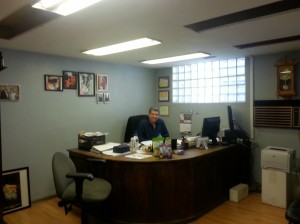
Shalom, owner of Shalom and Son’s: “Money isn’t the issue. When they give me money to set-up elsewhere in Vernon, I’m no better off. Because this is where I want to be. I’m happy here.”
Expressing even though they did buy out his property, he’s still not any better off than any other displaced person. Namely because this is where he wants to be. Stating if he wanted to move he would moved years ago. Holding his arms out he says, “Who would want to leave this? I’m happy here!”
As I looked at the amazing view just outside the doorway, I had to share his sentiments.
As I was visiting their site the business was in the middle of their biggest rush of the year. Everyone is rushing about their operation. We were just weeks before the Passover holiday. When their products are in highest demand.
Wanting to get out of their hair, I asked Shalom if I could snap a photo of him for my historical archives. He smiled for the camera. And I shuffled on my way.
See my very impassioned video, taken immediately after my visit:
—
This area of the surrounding the Sixth Street Viaduct is going to continue to change dramatically in the weeks to come. As businesses are finished being cleared to make way for the upcoming bridge demolition of the bridge above. The changes are breathtaking.

The location of the kosher food and wine facilities: In red are the sites which have already been demolished.
The lots where Shalom and Son’s and Teva used to operate will become the storage and processing sites for the rubble from the bridge demolition. As the city agree to restrict the processing to the Boyle Heights side of the river, and not on the already gentrified downtown Art’s District side.
It should also be noted that this is not the only lopsided concession to the downtown Art’s District. which secured an amphitheater and some sort of arts park feature in their area’s redevelopment.
The land here on the much larger east side will remain greatly undeveloped as open fields and bike paths. With only an afterthought of an soccer field feature being planned for the empty field left in and near the footprint of the bridge. [See “The Inequity of the New Sixth Street Bridge Plan.“]
In the most typical fashion and according to the way this community has always been treated, the city is taking what it wants for its roads here and is carelessly tossing aside the rest.
And so we see right before our eyes, the past revisiting us. As the major Jewish businesses of the area are once again leaving the neighborhood, for no other reason than being displaced by road works.
—

Shalom and Son’s Wholesale Foods, Anderson Street, Boyle Heights Flats. The larger building on the left was their kosher wine facility (now demolished), and on the right is their old offices.
For many years the subject of Boyle Heights had fallen out of the public consciousness. Few people seemed to remember the old neighborhood until recent years. That doesn’t mean there wasn’t a Jewish presence proudly doing business here all along.
Often times I have traveled all over Los Angeles, to enjoy and also lead Jewish ritual. And most often as I introduce myself, people have seemed shocked that I come hailing from Boyle Heights
A neighborhood which is tarnished, if not discounted entirely as less than “kosher” (on many levels) in many people’s minds.
In retort I always was armed with, “Boyle Heights is plenty kosher! You’re wine here for this simcha (joyous occasion), makes its way to this and every table in the area by way of our neighborhood.”
I’m really going to miss saying that!
Thank you to Shalom and Son’s and Teva Foods. For over twenty-years of service to the Boyle Heights community.
- Shalom and Son’s Wholesale Foods, Anderson Street.
- Offices on the east side of the street.
- Offices on the east side of the street.
- The wine storage warehouse before demolition.
- Teva Foods Inc. site, before it was demolished.
- Former Site of Teva Foods Inc.
—
To see what the area was like before the demolitions, see “Under the 6th Street Bridge (LA Bridge Series – Part I).”
Recommended Articles:
- “Havdalah as a Light to the Community: Reflections and Lessons from the Havdalah Circle of Boyle Heights.“ Sixth Street Bridge.
- “The Inequity of the New Sixth Street Bridge Plan.“
- The Old Houston Street Synagogue and Burial Site
- 2nd and Mathews Synagogue in Boyle Heights: An example of a small immigrant congregation, then and now

